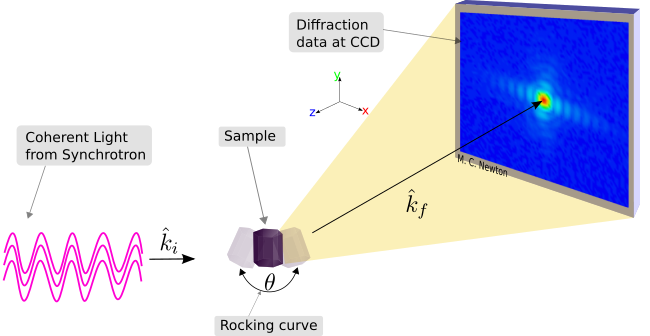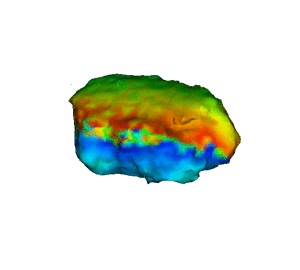Difference between revisions of "Research"
m (→Research Projects) |
m (→Research Techniques) |
||
| Line 50: | Line 50: | ||
</div> | </div> | ||
| − | Our group's research is focused on the study of nanomaterials using Bragg coherent | + | Our group's research is focused on the study of nanomaterials using Bragg coherent diffraction imaging (BCDI). BCDI is a lens-less far field imaging technique that allows imaging of nanometre scale crystalline materials with a sensitivity below a single angstrom. It is largely non-destructive and provides strain information at the surface and throughout the bulk of a material (J. Miao ''et al.'' Science (2015)). Conventional BCDI is performed by illuminating a sample with a spatially coherent X-ray source (a synchrotron X-ray light source) so that the coherence volume exceeds the dimensions of the nanocrystal (~ 1 micron). In the Bragg reflection geometry (see image above), scattered light from the entire volume of the crystal interferes in the far-field, producing a three-dimensional k-space diffraction pattern. Provided the diffraction pattern is sufficiently oversampled (R. H. T. Bates, 1982), iterative phase reconstruction methods (see [[#Non-linear Phase Retrieval Optimisation|Non-linear Phase Retrieval Optimisation]], below) are then used to recover the complex three-dimensional electron density and phase information (see animation above). The displacement of ions throughout the bulk is directly related to the phase information (shown as colour mapped onto the object) and can be used to obtain three-dimensional strain tensor information (M. Newton ''et al.'' Nature Materials (2010)). BCDI experiments are conducted at synchrtron facilities including the Diamond Light Source (DLS), European Synchrotron Radiation Facility (ESRF), Advanced Photon Source APS, Spring-8 and the SACLA X-ray free electron laser (XFEL) facility. |
=== Ab Inito Molecular Dynamics === | === Ab Inito Molecular Dynamics === | ||
Latest revision as of 12:13, 26 July 2024
Hear from our students on their exciting research and experiences.
Research Interests
Imaging Dynamics in Quantum Materials
The dynamics of materials are governed by their quantum properties. Strong coupling between lattice, charge, spin and orbital degrees of freedom often gives rise to emergent behaviour and multifunctional properties. Such materials are of great interest because the different properties may work together in uniquely different ways and lead to exciting new applications, if we could understand this better. For example, the coupling between magnetic spin and ferroelectric charge ordering can be utilised to develop magnetoelectronic devices where spin transport can be controlled electrically. This is advantageous for technological applications, including novel sensors and ultra-low power memory devices. As a result there is a vibrant effort to understand the underlying mechanisms at play.
When materials are reduced to the nanoscale, their behaviour is often very different from the bulk material due to quantum confinement effects and the increased surface-to-volume ratio that may result in behaviour that is dominated by surface properties. It is for this reason that our ability to directly image materials in three-dimensions at the surface and in the bulk can greatly increase our understanding of how novel phases develop and influence the material properties.
The aim of this project is to utilise Bragg coherent diffraction imaging (BCDI) to image in three-dimensions phenomena in a range of multifunctional quantum materials. This allows us to gain insight into the microscopic properties of the material and facilitates in identifying new and potentially novel applications for the materials.
Correlated quantum materials are those which the interaction between the valence electrons can strongly influence the materials properties. They are interesting as their unique properties are of considerable utility for device physics, functional materials and the study of fundamental condensed matter physics. Recently, there has been renewed interest in materials that exhibit a solid-solid structural phase transition at a critical temperature. Some of these materials exhibit a reconstructive structural phase transition (SPT) at some critical temperature that occurs on the femto-second time scale. There is still a great deal that is not known about the dynamics of this phenomenon as the ability to probe ultra-fast transitions remains largely inaccessible to conventional techniques. An example is vanadium dioxide (VO2), where spontaneous (non-diffusion limited) atomic rearrangement occurs due to external excitation. Switching speeds on the femto-second timescale have been observed.
The aim of this project is to make use of femto-second Bragg coherent diffraction imaging (BCDI) to study ultra-fast SPT's in nanoscale quantum materials. This process became possible with the advent of X-ray Free Electron Laser (XFEL) radiation facilities. By imaging and hence determining atomic motions during the SPT and making comparison with ab-initio simulations, we are able to develop models to describe the observed behaviour which serve as a platform to develop next generation devices.
Machine Learned Phase Retrieval
Deep learning has emerged as a powerful alternative to the iterative phase retrieval approach, that can provide robust reconstruction of Fourier-space diffraction pattern data into three-dimensional real-space images where iterative methods often fail to solve the phase retrieval problem. This project is focussed on further developing machine learning methods to understand better how artificial neural networks function and how to implement efficient and robust machine learning methods that are universally applicable to all Bragg coherent diffraction imaging (BCDI) data.
Nanomaterials for Energy Harvesting
New materials for the capture of light and ambient vibrational energy such as photovoltaic devices and piezoelectric mechanical recouperation devices can potentially enable low-cost and innovative renewable sources of energy while eliminating negative effects on the environment that are inherent when non-renewable sources of energy are utilised. The development of portable energy harvesting power sources as an alternative to batteries is an attractive prospect that will permit a new class of renewable energy devices that can operate indefinitely.
The aim of this project is to design, fabricate and test a range of novel energy harvesting devices using state-of-the-art facilities within the Southampton Nanofabrication Centre (Zepler Institute) with the aim of optimising the performance characteristics. Extensions will include exploring the role of defects in nanocrystal heterojunction interfaces formed with organic conductive polymers. The outcome will be a complete modelling framework that is able to accurately predict the performance characteristics of devices for a range of configurations.
Research Techniques
Coherent Diffraction Imaging
Our group's research is focused on the study of nanomaterials using Bragg coherent diffraction imaging (BCDI). BCDI is a lens-less far field imaging technique that allows imaging of nanometre scale crystalline materials with a sensitivity below a single angstrom. It is largely non-destructive and provides strain information at the surface and throughout the bulk of a material (J. Miao et al. Science (2015)). Conventional BCDI is performed by illuminating a sample with a spatially coherent X-ray source (a synchrotron X-ray light source) so that the coherence volume exceeds the dimensions of the nanocrystal (~ 1 micron). In the Bragg reflection geometry (see image above), scattered light from the entire volume of the crystal interferes in the far-field, producing a three-dimensional k-space diffraction pattern. Provided the diffraction pattern is sufficiently oversampled (R. H. T. Bates, 1982), iterative phase reconstruction methods (see Non-linear Phase Retrieval Optimisation, below) are then used to recover the complex three-dimensional electron density and phase information (see animation above). The displacement of ions throughout the bulk is directly related to the phase information (shown as colour mapped onto the object) and can be used to obtain three-dimensional strain tensor information (M. Newton et al. Nature Materials (2010)). BCDI experiments are conducted at synchrtron facilities including the Diamond Light Source (DLS), European Synchrotron Radiation Facility (ESRF), Advanced Photon Source APS, Spring-8 and the SACLA X-ray free electron laser (XFEL) facility.
Ab Inito Molecular Dynamics
Our group is also engaged in large scale supercomputer simulations of structural phase transitions. We make use of the Iridis high-performance computing facility to perform ab-initio molecular dynamics (MD) simulations of structural phase transitions under various conditions. Simulations of the ultra-fast SPT allow us to bridge XFEL experiments to current theory and to make predictions as to how the behaviour of a material changes under various conditions. This might relate to a change in the immediate environment of the material or the materials use in a heterostructure device setting. To the right is an animation resulting from an ab-initio simulation of a supercell of vanadium dioxide undergoing a structural phase transition from monoclinic to tetragonal crystal structure (D. Plasienka et al. Phys. Rev. B (2017)).
Non-linear Phase Retrieval Optimisation
When Bragg coherent X-ray diffraction imaging (BCDI) measurements are performed, phase information is in general lost as only intensity measurements can be made. It therefore becomes necessary to reconstruct the phase information subject to some a priori information. In general phase retrieval methods operate by the application of iterative projective algorithms that cause the objective function to converge toward the optimal solution by the repeated application of constraints at each iteration (D. Sayer (1952), R.W. Gerchberg and W.O. Saxton (1972), J. R. Fienup (1982)). One important application of phase retrieval methods is to obtain real-space images of nanoscale structures by inverting measured diffraction patterns. Correlated electronic materials that undergo a spontaneous crystalline deformation can experience a significant strain. This can pose a challenge when reconstructing and interpreting phase information obtained from BCDI. To address this challenge, we have developed the Interactive Phase Retrieval Suite, software package that allows for real-time visualisation of the reconstruction of phase information in both two and three dimensions. This is used for analysing diffraction patterns obtained from coherent X-ray imaging experiments and for algorithm development.



